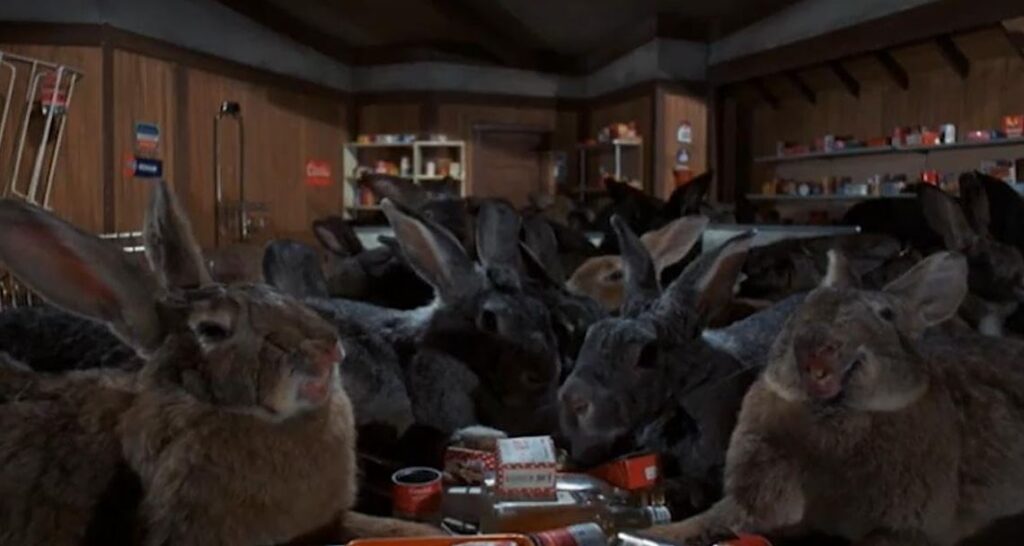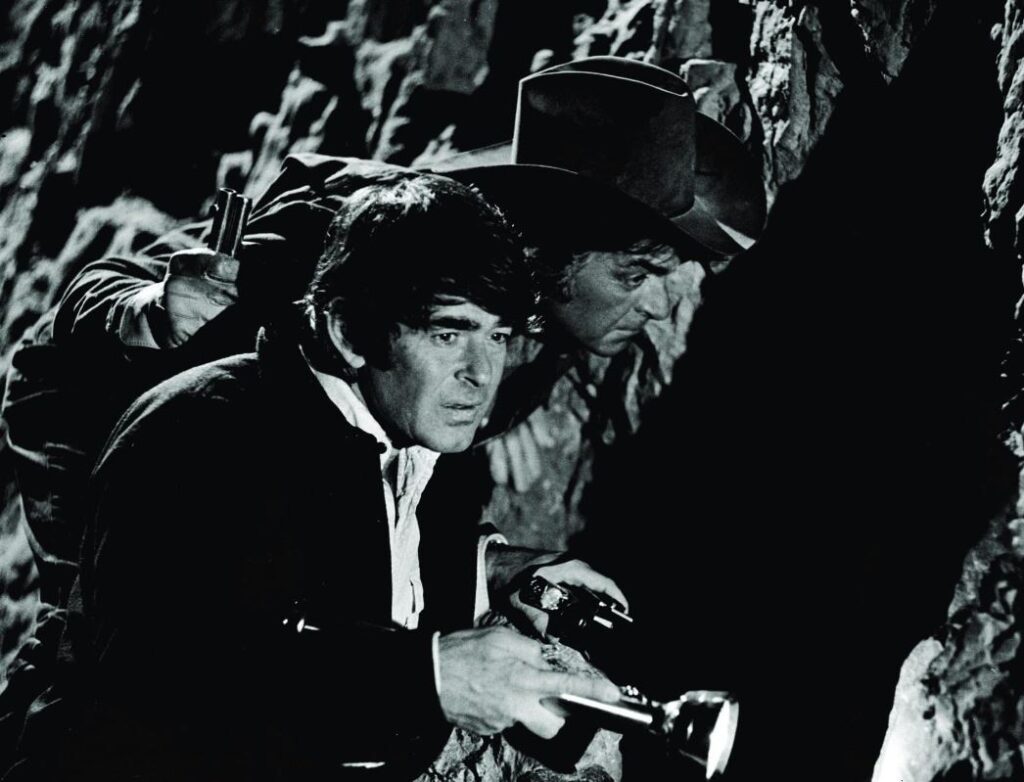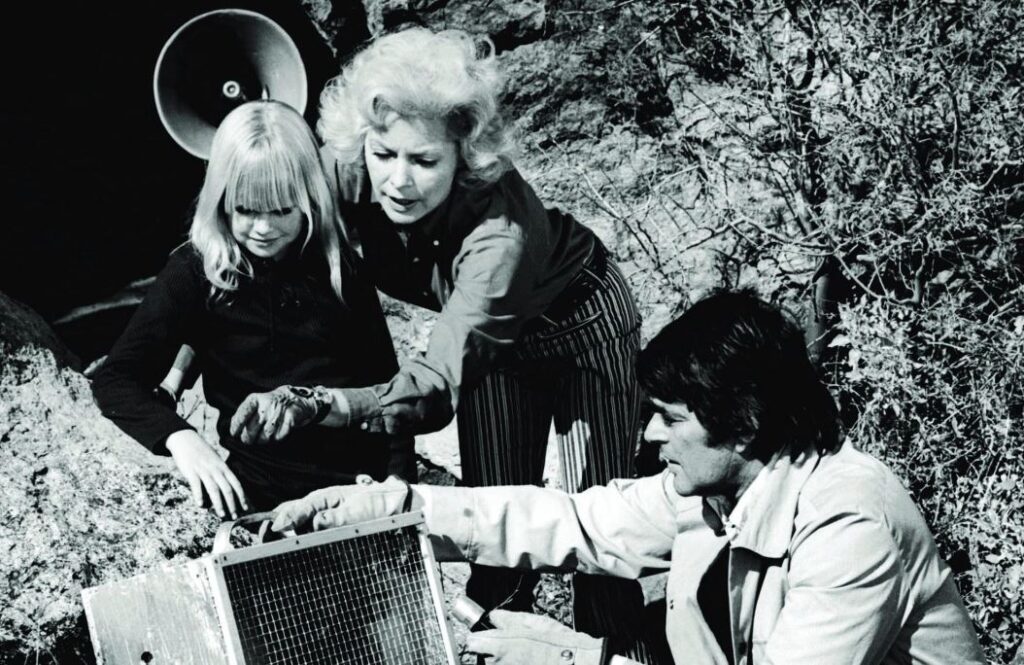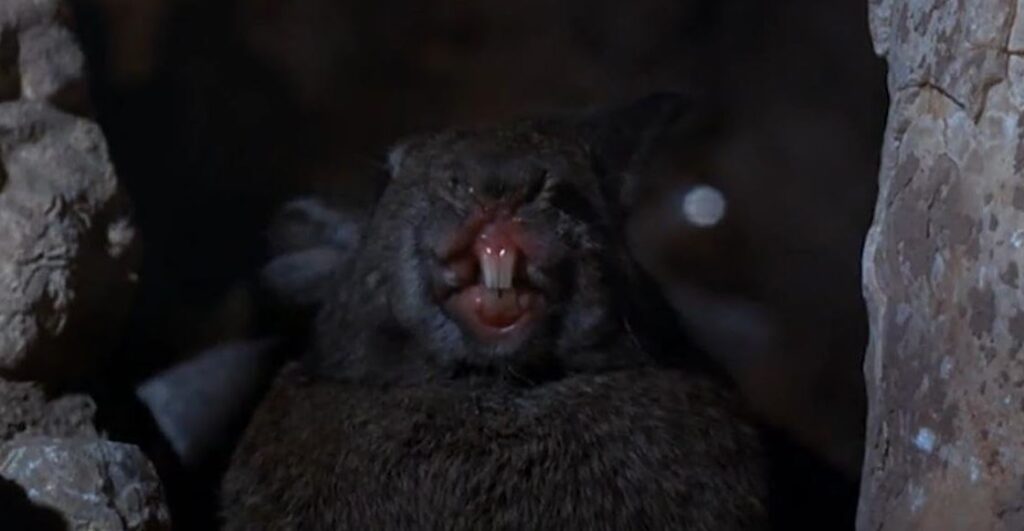
Funny thing about bunny rabbits, they don’t scare in quite the same way as, say, roaches, rats, sharks, or frogs. Even giant rabbits, meat-eating and bloodthirsty at that, are more plush toy than vengeful beast, while a whole gang of the sumbitches simply a cause for hugs and grins, not shriek-filled terror. So it is amusing indeed that in the painful year of 1972, director William Claxton scanned the horizon of American film and said that while the rivers ran brown with trash, the trees wilted away from bad air, and toxins killed the sweet, the innocent, and the beautiful, it was the rabbit we had to fear.
Bugs Bunny, perhaps, had set the stage with a new level of sass and sarcasm, but who knew the species was a mad scientist away from full-blown murder? On its face, the very idea of killer cuties sounds more ironic than genuine, but at no stage is this a sly diversion from the truth. Perhaps it takes a B-movie to wash away the last true sacred cow after all. I’m not sure if Claxton ever worked again, but it would not have surprised me had he moved on to shotgun-toting toddlers, or a Holocaust comedy of some kind. That said, not even he had the chops to give us the world’s first Golden Retriever assassin. Or a twist on Jaws using dolphins.
Night of the Lepus (based on a must-read novel called The Year of the Angry Rabbit) begins with a somber newscast, lending the film the gravitas it needs, given its title and subject matter. Apparently, the earth has a whole lot of problems – the usual “nature out of balance” sort of thing – and in Australia, there’s a rabbit infestation never before seen. But as this is Australia, mankind is fighting back with violence and cruelty, butchering the sweet bunnies with methods decidedly unsound. But then the report takes a turn. It seems that rabbits are also out of control in the American Southwest, and I’ll be damned if he doesn’t have the color footage to prove it.
With so many rabbits, the farmers are losing valuable crops, with the money soon to follow. What’s behind this population explosion? And what can be done short of spraying DDT, setting fires, and purchasing millions of dollars’ worth of dynamite? There’s no shortage of good ol’ boys offering solutions, but each one is considerably more damaging to the environment. No, this is a matter best left to the egghead set. So instead of following the righteous anger of those who ride the range, the rabbits will meet their match in one Roy Bennett: educator, scientist, and brilliant intellectual.

Only Roy has done lost his mind. It seems he has a secret serum – ingredients unknown – that can be injected into 50 test rabbits, who will then pass tainted blood along to others, thereby interfering with the reproductive cycle and killing the lot of ’em. It’s just a theory, of course, and wholly unproven, but dammit, it just has to work. Only Roy, along with partner and wife, Gerry (Janet Leigh!), saw fit to allow his young daughter into the lab, and you know damn well she’s going to want a rabbit to take home.
Once her parents’ backs are turned, she switches a rabbit from the control group with one of the infected variety, and within minutes of having it home, allows it to escape into the wild. This is unknown to the Bennetts, and, of course, the unsuspecting public at large. But surely they wouldn’t fear a single bunny with super-sized hormones coursing through its veins, would they? It’s not like he’ll fuck like a rabbit or anything and turn 1 to 1,000 over a long weekend. And with the approval and aid of fellow scholar Elgin Clark, what could go wrong? Matters are helped by the fact that Clark is played by DeForest Kelley with the era’s thickest moustache, and second tightest pair of slacks.
Science is matched step for step by Cole Hillman (Rory Calhoun), a rancher so tirelessly masculine he all but sends the rabbits scurrying for cover with a single glare. But as much as Cole is willing to sacrifice his land for the greater cause, he’s not about to abandon his trusty shotgun. But when Bennett discovers a giant rabbit track, Cole knows the score at last. This will take more than raw muscle and firepower – he’ll need ideas to boot. In a flash, the Bennett child is wandering around an abandoned gold mine with her new friend, and while looking for desert eccentric Cap’n Billy, the girl heads straight into the rabbit love nest. And there, before her, is Billy, torn to shreds and quite likely stone dead. She freaks the fuck out, and the film uses the opportunity to insert a bizarre montage of screams, rabbit teeth, a sweaty face, and bloody fur. She’s soon rescued by her parents, though few are completely convinced that the girl saw a rabbit the size of a small car. But why would she lie?

Well, mutilated bodies don’t lie, and quite soon, a poor truck driver is savaged while stopping roadside for no other reason than to be attacked by the rabbits. The poor man yells with deafening power, but the movie denies the audience a payoff, and not for the last time. Unfortunately, while rabbit teeth should provide ample opportunity to watch flesh tear and wounds explode with blood, the killings on display – at least a dozen – are muted and somewhat tame. Yeah, we often get the aftermath (a picnic area is stained red by a butchered family of four), but no real suffering. Death is quick and painless, and one can’t help feeling ripped off. This may or may not have something to do with the fact that the most prolonged attack appears to be a human being battling another human being in a cheap rabbit suit, but as this is 1972 and rabbits are not, in fact, seven feet long, we can put aside our need for absolute realism. Still, while the on-screen gnawing remains low, the truck driver’s dead body is one of the era’s best.
After the mine is investigated further, it is decided that the only way to get rid of the rabbits is to blow the entire thing to pieces. But before the dynamite can be set off, nerdy Roy wants to capture a live specimen for study. Of course he does. Down and deep he goes, wasting time, and without surprise, he is attacked. Bloodied slightly, he escapes in time, and the mine is blown. Shots of panic follow, and from all appearances, the bunnies are buried alive under dirt and rubble. Only they’re not, and every last one of them escapes through a hole at the top.
Stronger than ever, they run and hop through the desert, sounding a bit like an obese child running up the stairs. There’s also an occasional squeak amidst the heavy breathing. Within seconds, the rabbits attack Cole’s farm, munching on horse and man alike. Tucking his family away in a cellar, Cole guns down as many rabbits as he can, though some manage to chew through the wood to get at the hiding humans. “Sounds like a cattle stampede,” he cries, though these buggers fly into the air like missiles when shot from below. Finding little flesh on which to feast, the rabbits turn towards the general store, happily obliging the owner with her final wish to have her throat chewed away. Even then, the old lady lets loose with a scream loud enough to shatter what glass the rabbits left unbroken.

More great scenes abound: a man fighting off a rabbit with a chair, Cole hitchhiking while waving a shotgun (did he see Frogs?), and Janet Leigh setting a bunny on fire. Soon, the National Guard is mobilized, the governor is called, and cops crash a drive-in theater with the announcement, “Attention! Attention! Killer rabbits are on their way!” This being the Nixon era, no one seems to find this somewhere between unbelievable and batshit, so they leave the area in an orderly fashion. Tanks roll in, more troops arrive, and almost as if on cue, a priest shows up to give Cole a ride. Bennett also comes up with the idea to electrify the train tracks, as if this should have been the first and only course of action. But Bennett’s wife and daughter are in trouble, and the editor gives us two dozen shots of rabbit teeth, eyes, and bloody fur to prove it. No matter, as Roy shows up in a helicopter to save the day. Right then, the film decides to show our rabbits in all matter of slow motion – leaping, jumping, and stretching. We see them from below, on high, and through every conceivable angle. It’s like a bunny version of Riefenstahl’s Olympia.
At last, the final battle. As the rabbits attack the National Guard one last time, we hear, almost as a throwaway, that five people have been found dead in a trailer park. The rabbits again? No one’s talking. The tracks are electrified as promised, and soon, our little bunny Normandy awaits. We see rabbits on fire, electrocuted, and blown apart. Within thirty seconds, all are dead. They screamed, flipped, and gnashed, but not a single one survived. After the smoke clears, a new day dawns. Months later, however, despite hopeful words from Cole, the film ends as all do from the Nature’s Revenge genre – with a close-up of the offending creature as ominous music plays on the soundtrack.

They’ll be back, friends, rest assured of that. How do we know? Because these rabbits speak Spanish, and they have an affinity for farm work. Indeed, Night of the Lepus speaks to the illegal immigrant crisis to come, where Mexican laborers invade the entirety of the Southwest, at first allowing a balance, while eventually becoming a costly, unmanageable nightmare. Oh no? What about the man who yells, “The horde is heading for the perimeter!” Or Sheriff Joe, a tough law and order type, who reasons, “What we need is a fence ten miles long and twenty feet high.” And with all the breeding, unintelligible chatter, and movement at night (“They only move during the dark!”), we have a terrifying parable with deadly electricity as the only real solution. What, no one you know has called for an electrified fence along our Southern border? You must live in Vermont, sir.
THE OFFICIAL STORY
Science gets cute, plays god, and turns the world’s most aww-shucks creature into a bloodthirsty maniac.
THE TRUTH
Unchecked immigration will destroy the Southwest, even while our produce remains quite reasonable.
LEGENDARY ACTING TALENT SLUMMING FOR DOLLARS
Janet Leigh could not survive Norman Bates. Giant bunnies, however, she can handle. As for Dr. McCoy, well, he’d be in a deep depression until Captain Kirk worked with spiders.
HUMAN DEATH WORTH THE PRICE OF ADMISSION
The human jigsaw puzzle was a nice touch, but one can never go wrong with a slashed throat.
DOES A LOCAL ECCENTRIC SOUND THE ALARM BELL?
Crazy Cap’n Billy died so that others might live. Fair enough for the guy who let kids play around in an abandoned mine.
WHAT ABOUT DISBELIEVING LAW ENFORCEMENT?
A few cops seem to suggest a serial killer, but who can fault them for not first imagining giant rabbits?
AND OUR CREATURES?
Even bloodied, the rabbits are sweet and innocent and impossible to root against. May they live on to torment other towns with their soft fur and twinkly noses.
Leave a Reply